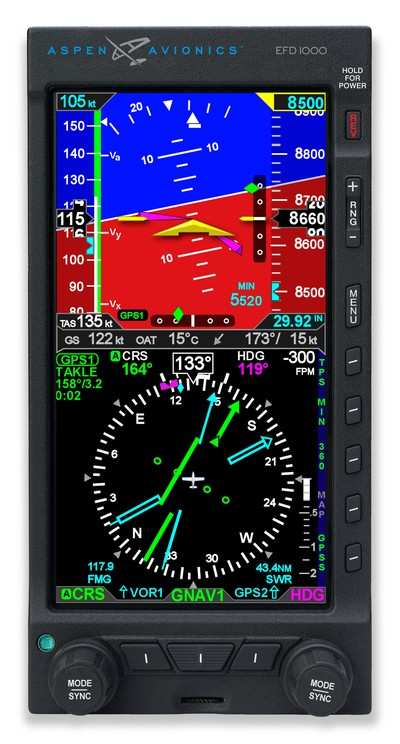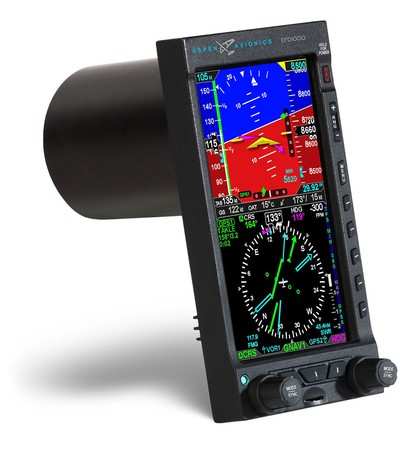Designed For Certified GA Planes
Aspen Avionics is evolving... and so is its product line. On
Monday at AirVenture 2007, the Albuquerque, NM-based avionics
manufacturer introduced its Evolution Flight Display system,
intended exclusively for certified general aviation (GA)
aircraft.

Aspen tells ANN the Evolution system is modular, expandable and
upgradable; it's easy to afford, easy to install and easy to own.
Comprised of three models of Primary Flight Display (PFD) starting
at $5,995, and two models of Multi-Function Display (MFD) starting
at $4,995, the Evolution system enables aircraft owners to upgrade
their primary flight instrument "six pack" to glass cockpit
technology all at once, or in stages. Easy and inexpensive software
upgrades add new features and capabilities, while future-proofing
the system and protecting owners' investments.
"At Aspen Avionics, we believe that installing the latest
avionics technologies and safety advances in GA aircraft shouldn't
have to mean emptying your bank account," says Doug Cayne, Vice
President of Marketing. "And you shouldn't have to throw out the
old every time you want to add something new."
Starting with a common hardware platform containing a miniature
solid-state air data, attitude and heading reference system
(ADAHRS), the EFD1000 slides easily into existing 3-inch instrument
panel cutouts for quick and easy replacement of old analog gauges,
with little to no panel modification, or mounting heavy remote
boxes. This stunningly innovative, patent-pending design leads to
greater capability, and lower purchase and installation costs, than
anything else on the certified market today.

The EFD system is intended for the majority of the existing GA
fleet. Different software loads turn each EFD1000 into one of three
levels of PFD or an MFD. The first EFD1000 is typically installed
as a Primary Flight Display, replacing the old attitude indicator
and directional gyro (DG) or HSI. A second EFD1000 may replace the
altimeter and VSI and be configured as a Multi-Function Display.
Together, these two tubes deliver all the great features of glass
cockpit systems costing several times the Evolution's price.
Add a second MFD to round out the six pack replacement, and gain
even more capability. Because of its common hardware platform, the
EFD1000 MFD has the same ADAHRS as the PFD, providing full sensor
redundancy for backup -- a capability unavailable in other GA glass
cockpit systems at any price. In the unlikely event the PFD fails,
the MFD can revert to PFD mode without skipping a beat. That's a
capability other GA glass cockpit systems also offer... but Aspen
says Evolution goes beyond by also offering a backup, in case of an
ADAHRS sensor failure -- a feature typically found only on large,
turbine aircraft, and at a much higher prices.
The Evolution Flight Display 1000 can be configured as one of
three models of PFD, each upgradable to the next level through
software. The EFD1000 Pilot PFD is the entry-level product,
designed for the largely VFR pilot. Costing little more than the
overhaul of the analog gauges it replaces (the attitude indicator
and directional gyro), the Pilot delivers the primary benefits of
glass cockpit technology at a breakthrough price. The integral
ADAHRS provides digital accuracy and reliability while adding many
new capabilities. Airspeed and altitude tapes on the attitude
indicator put all primary flight information in one place right in
front of the pilot.
The slaved directional gyro with heading bug eliminates the need
to keep manually resetting the heading indicator to correct for
gyroscopic precession. The Pilot has many more capabilities than
analog gauges could ever deliver. For example, a built-in altitude
pre-select and alerter; graphical display of GPS flight plan legs
and waypoints right on top of the DG; an air data computer to show
true airspeed and real-time winds and temperatures aloft; and an
integral backup battery and emergency GPS, to help the pilot keep
flying right even in the event of a total electrical system
failure. The EFD1000 Pilot PFD lists for $5,995, and will be
available in Fall 2007.

The EFD1000 Pro PFD adds professional-grade navigation and
integration on top of all the Pilot features and capabilities. A
full electronic HSI, with Course Selector and dual Bearing
Pointers, and an Arc mode optimized for the moving map provides the
same navigation instrumentation the pros fly on the biggest iron. A
full Attitude Director Indicator, with singlecue flight director,
lateral and vertical deviation indicators for precision approaches,
and dedicated approach minimums setting and alerting, tighten a
pilot's instrument scan for flying instrument approaches more
easily and safely.
The Pro integrates with whatever is already in the panel,
supporting dual ARINC 429 GPS, dual RS-232 GPS and dual VHF
navigation radios. It also integrates with the vast majority of GA
autopilots and flight directors in the fleet today. Additionally,
the Pro includes integral GPS Steering, enabling modern GPS to fly
from leg to leg, and to fly curved flight paths (like course
reversals and holding patterns) without pilot intervention. And
optional software enables the Pro to overlay datalink weather,
traffic and terrain on the HSI in its map mode. The EFD1000 Pro PFD
lists for $9,995, and will be available in Fall 2007. The EFD1000
Pilot PFD can be upgraded to the Pro model by means of a software
upgrade that lists for $3,995. The EFD1000 ATP PFD is Aspen's
ultimate PFD, adding many MFD capabilities to the PFD. In addition
to all Pro features, the ATP supports sectional-style moving maps
on the nav display (in HSI or Arc modes), and includes all hazard
awareness interfaces (datalink, weather, traffic and terrain)
standard. It lists for $12,995, and will be available in Fall
2008.
The Pilot can be upgraded to the ATP model through a software
upgrade that lists for $3,995. Two MFD Models The EFD1000 MFD
delivers all the great features of a Multi-Function Display, along
with a duplicate set of ADAHRS sensors for full redundancy and
backup capabilities. It includes flexible screen layouts to suit
each pilot's preference, and to present multiple information
sources simultaneously in different regions of the screen. Keep a
large sectional-style moving map in view to help situational
awareness, while using smaller tile windows to constantly monitor
the backup attitude solution and traffic or other hazards, or a 3D
terrain visualization display.

And should the PFD ever fail, whether a failure of its display
screen or of its sensor set, the MFD can revert to assume all the
PFD capabilities at the touch of a button. So the backup
instruments will be identical to—and right next to—the
primary instruments -- no more partial panel!
The EFD1000 MFD lists for $7,995, and will be available in
Spring 2008. The EFD500 MFD is a lower cost version of the EFD1000
MFD. It delivers all the same great MFD features and functions at a
lower price, but without the backup set of ADAHRS sensors. It is
ideal to add as a third EFD tube to round out a six-pack
replacement, and can be installed as a slave display off the first
EFD1000 MFD with just a simple Ethernet connection, making
installation a snap. The EFD500 MFD lists for $4,995, and will be
available in Spring 2008, according to the company.
 Aero-News: Quote of the Day (05.20.25)
Aero-News: Quote of the Day (05.20.25) ANN's Daily Aero-Term (05.20.25): Handoff
ANN's Daily Aero-Term (05.20.25): Handoff ANN's Daily Aero-Linx (05.20.25)
ANN's Daily Aero-Linx (05.20.25) Airborne-NextGen 05.20.25: Drone Regs, Zero-Emission Cargo, Door-Dash Drone
Airborne-NextGen 05.20.25: Drone Regs, Zero-Emission Cargo, Door-Dash Drone Airborne 05.19.25: Kolb v Tornados, Philippine Mars, Blackhawk Antler Theft
Airborne 05.19.25: Kolb v Tornados, Philippine Mars, Blackhawk Antler Theft





